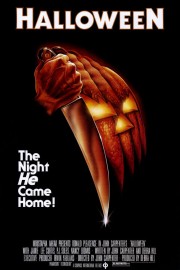Halloween
Although Tobe Hooper’s “The Texas Chain Saw Massacre” was the unofficial beginning of the modern day slasher film, with Hitchcock’s “Psycho” acting as an early prelude itself, the trend did not begin properly until this film– John Carpenter’s “Halloween,” which set the template others still follow today. It is, arguably, the most influential horror film of all-time.
That influence begins with the moody, evocative musical score, by Carpenter himself. As with Bernard Herrmann’s music for “Psycho,” Carpenter’s approach is simplicity itself, both in terms of orchestration and in theme. And it’s use of synthesizers was almost a revelation, it seemed; after this haunting, minimalist theme, it was almost a necessity for “Friday the 13th,” “A Nightmare on Elm Street,” and many other films to follow, to go electronic in order to create an indelible sense of unease and suspense in the viewer whenever Jason Vorhees or Freddy Kruger came on screen. Or in this case, Michael Myers.
The story is well-know by this point. In 1963, a young boy named Michael Myers snaps, and kills his sister on Halloween night. He spends the next 15 years in a mental hospital, where his psychiatrist, Sam Loomis (Donald Pleasance), hopes to keep him on a nighttime trip to the hospital. Unfortunately, he manages to escape, and makes his way back to his hometown of Haddonfield, Illinois to share the terror with others, focusing on a young woman named Laurie (Jamie Lee Curtis, in her debut) and her friends. Like the theme, this is simplicity itself, and again, the basic template for all who came after.
One trend this film DID start, without question, was the idea of a killer who goes after teenagers. That’s a tradition that hadn’t been seen in the horror genre since the last big youth explosion of the ’50s and the Baby Boomer generation. This time, however, filmmakers had more leeway in terms of violence and sexual content, meaning we not only see blood, but also some gratuitous nudity as the high schoolers in the film hook up with one another. Gone are the days of just parking and making out– now, we saw them going to bed together, which became, needless to say, a big selling point for the kids. However, it was also a warning, since having sex inevitably led to death in these movies, with only the virginal (or, as “The Cabin in the Woods” would clarify 34 years later, “virginal,” with quotes around it) heroine surviving most of the time. But when you think about it, not too many people actually get killed in this film– including Michael Myers’s sister in the prologue, I only counted five deaths. A shockingly low body count by today’s standards.
It’s hard for me to say that a film truly terrifies me nowadays. What I admire most about horror films tends to be their ability to project unease through their manipulation of things like sound, cinematography and visual effects, music, and editing. On all of these fronts, John Carpenter’s film (which he co-wrote with Debra Hill) remains at the pinnacle of its genre. No, it doesn’t scare me when Mike Myers is seen by Laurie, stalking her, and then, is gone the next time we cut back to Myers’s location, but that’s only because I’m so familiar with the convention at this point. What really effects me in watching the film is the mood that Carpenter establishes from the outset, and doesn’t back away from even as the end credits roll, and Myers, improbably, gets up after being shot by Loomis several times, and falling from a two-story house’s bedroom window, ready to haunt another day. Yes, it set up the trend of the “can’t be killed” serial killer, which would make studios plenty of money over the years, but one can’t fault it for how well the film did it’s job– only for how few others really learned the lessons it had to impart. Such is the burden of being a groundbreaker, which Carpenter’s film truly is.










